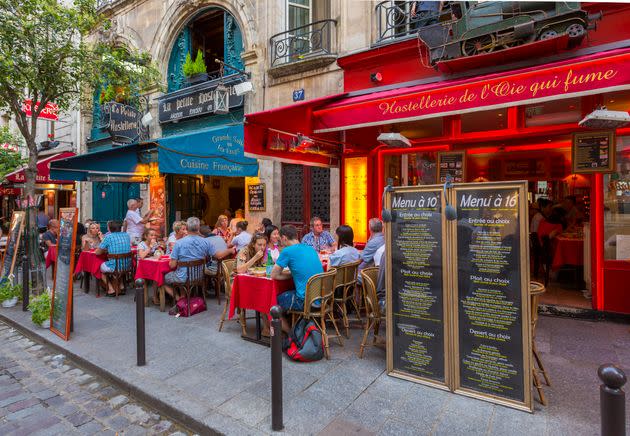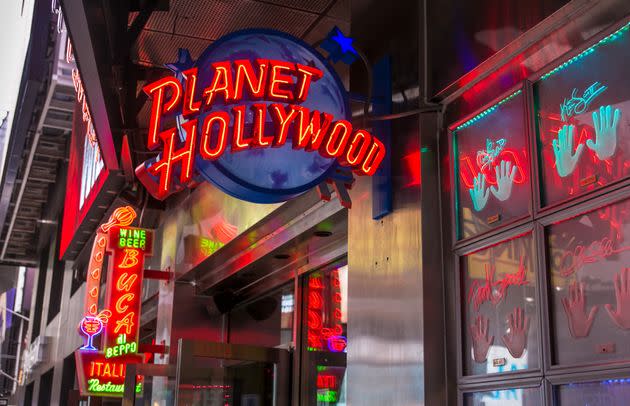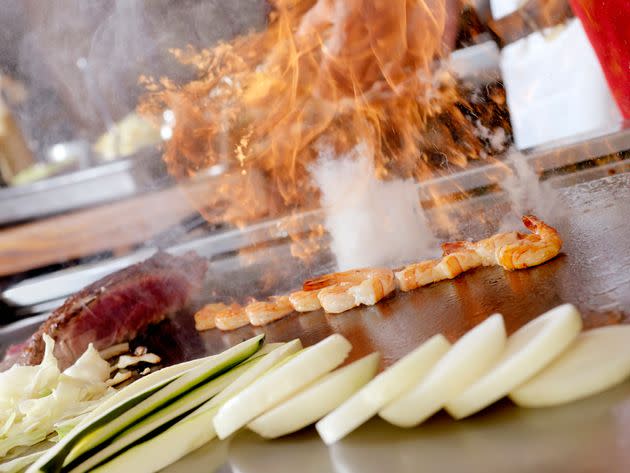6 Red Flags You're About To Eat At A Tourist Trap Restaurant

For those who travel to eat, meals while away from home are precious. A marquee meal can be the most memorable highlight of a trip, and when you only get so many per day with no do-overs, there is literally no room for mediocre food. And even harder to stomach is when it’s expensive, inauthentic, or — even worse, in a world with such diverse cuisine — boring. In other words, a tourist trap restaurant.
What is a tourist trap restaurant?
According to a study by online passport photo service provider PhotoAiD, the top three criteria that make a place a tourist trap are above-average pricing, amenities tailored for tourists, and a lack of cultural authenticity. But these traits aren’t always immediately apparent, so we asked a diverse panel of culinary research-driven travel tourism pros and chefs to add more perspective.
From a publicity standpoint, Taryn Scher (“The Sparkle Boss”) of TK PR considers a tourist trap “a spot that has a lot of buzz but doesn’t really have the flavors to back it up.” Sadly, this can also include famous institutions.
“There are long-standing restaurants that exist on buzz, simply for the sake of ‘You have to go to X if you’re visiting Z.’ Some of these are even places you might want to say you visited, even if the food is second-rate,” she said. Based on 15 years of representing destinations such as Greenville, South Carolina, and The World Equestrian Center in Ocala, Florida, she’s found that, while there are exceptions, “these aren’t really the place for serious food lovers who travel for food.”
Executive pastry chefClaudia Martinez and “Top Chef” contestantHector Santiago — both James Beard semifinalists — feel that intent is what defines a tourist trap.
“To me,it’s a place that makes what they assume a traveler would want … like pizza how they think an American would want it rather than making a delicious version of pizza that has their spin on it,” Santiago explained. As a Puerto Rican native, he finds this particularly grating because “I want people to try the authentic cuisine,” he said. “To me, one of the best parts of traveling is immersing yourself somewhere to live like a local.”
Martinez dismisses any restaurant that’s “not locally owned and doesn’t embody the city’s culinary talents as a whole, but rather, focuses on turning tables for profits and promoting sub-par food.” This translates into higher prices with lower quality, she says, with a focus on the biggest payoff for the owners instead of the best experience for diners.
All of this is part of why nearly 70% of travelers surveyed by PhotoAiD said a visit to a tourist trap diminished their overall enjoyment of a trip — and is why you should keep these six red flags in mind.
1. A Whole Lot Of ‘Come Hither’
All six experts HuffPost spoke to listed this as their No. 1 warning: beware a loud, overeager welcome, starting with décor. Scher cautions that “theme-y spots that are overly kitschy, or any beach bar that’s covered in $1 bills are probably tourist traps.”
“And most are generally pretty loud,” she added.
Okan Kizilbayir, chef de cuisine atThe Ritz-Carlton, Amelia Island, agrees with the latter. He says of his home country, “In Turkey, instead of shiny and loud entrances, there are hosts with a menu in their hand and they’ll constantly talk to you to get you in the restaurant and tell you that they’ll give you a big discount.”
And after traveling through 30 countries in seven years doing culinary research,Jared Hucks, chef-owner of The Alden in Atlanta, agrees that employees blatantly trying to lure travelers is the brightest red flag out there. But also, “I avoid any places on the ‘beaten path’ with menus with multiple languages posted in front of the restaurant,” he said.
Santiago bluntly added, “I walk the other way when I see someone standing outside soliciting travelers as they pass out menus in 100 different languages.”
Worse yet is if said multilingual menu is plastic-coated and has pictures of the food, according to Italian native Piero Premoli, executive chef and partner of Pricci in Atlanta. Whenever he returns to his homeland for the culinary deep dives that inform his monthly regional menu dinner series, he steers clear of those and checkered tablecloths.
2. Location, Location
It’s hard to resist the convenience of proximity, especially when you’ve been walking around all day and your stomach’s growling. But being close to major attractions usually comes with big crowds and high rents that “hyperlocal spots wouldn’t be able to afford unless they’re feeding tens of thousands of visitors a week,” Scher said. And as Martinez points out, “larger-scale, over 200-seat operations, usually in downtowns” are indicative of corporate ownership, with the marketing and budget to design a tourist trap.
“I want to make sure my money is being spent on people who work hard to put out their local cuisine — not mass-market corporations or tourist traps that purchase food that’s already made,” she said, which is why she actively seeks restaurants off the main roads.

3. Size Matters
Another example of how bigger isn’t always better is when it comes to menu size. One of Kizilbayir’s peeves is “Too many items on the menu! And too many different styles or regions.” If a restaurant is trying to be everything to everyone, it’s unlikely to be cooking seasonally or to the destination. That’s why Santiago said, “I also stay away from places that overly complicate their menus by throwing everything on a plate. You can’t get everything from an area on one plate!”
A giant menu also increases the likelihood that it’s going to be pretty uninventive or “generic, Anywhere, USA,” as Scher put it, with basic items like burgers. Or it might contain foods that are American despite having other associations — for example, Premoli points out chicken Parm, fettucine alfredo, and spaghetti and meatballs.
And within that large menu, “Watch out for excessive fried appetizers,” Premoli said, coming back to Martinez’s point about premade food. A menu rich with deep-fried selections means the restaurant has prioritized food that’s frozen, cheap, quick and easy to prepare. “Also watch for repetitive [ingredient] pairings and big frozen food trucks parked there in the morning,” he adds, both of which signal the above.
4. Predictable Desserts And Drinks
Everyone has their one favorite dessert — a good ol’ standby that you can count on. But as a pastry chef, Martinez knows how to recognize tourist traps by their after-meal sweets. “Classic cheesecake, molten lava cake, key lime pie … these aren’t usually made in-house,” she shared. Ice cream is also usually brought in by a restaurant supplier unless otherwise stated.
Too-perfect sliced cakes and pies are also signs of mass production. “If there are desserts on display or on the menu with pictures, or outside signage of the desserts, especially in a restaurant that seats over 200 people, it usually means they’re supplied by commercial bakers,” she revealed. And if desserts lack description and are decorated the same way (“Think whipped cream star piping with mint garnish, strawberries sliced like a rose, powdered sugar on everything,” she says), it’s unlikely they have a pastry chef on staff baking their goods.
Scher gauges by available drinks. “Look at the wine list, the cocktails, beers … that’ll tell you a lot about a restaurant! Ask yourself, How Target wine aisle is the list?” Instead, look for local beers to indicate regional tie-ins and inventive cocktails to show attention to and investment in professional craftsmanship. But if there’s nothing more than your major beer brands and “your typical appletinis and cosmos,” she said, you might want to rethink using up a vacation meal there.
5. Spectacle And Superlatives
On the other side of the humdrum spectrum are the spots that are irresistibly photogenic. Anything too sparkly is suspect, according to Santiago and Kizilbayir, who quickly flags Insta-spots when “people have a cue to take pictures and the restaurant is showcasing more merchandise than what they should sell, which is good food.”

Additionally, he spears what he calls “stupid tableside shows,” not to be confused with genteel tableside presentation. He defines these shows as food served with “lowbrow or loutish style to get attention.”
“They don’t care about the food; they just want people to take pictures or videos and post them on social media for attention” — and to make money off this new form of tourist trap, he said.
This kind of misrepresentation and manufactured hype is exactly why Martinez is wary of what she calls “showy or Instagram-forward restaurants” when she travels, as well as anyone that uses overly effusive praise in their social coverage. Key turnoffs for her include the words “the best” or “amazing,” while Scher says she’s “hesitant to believe any restaurant’s website or marketing that claims they are No. 1 for anything in their city but don’t say where they earned that nod.”
“Anyone can claim to have the best anything if they want to, so make sure you look into that achievement before just believing it,” she said.
6. Your Would-Be Fellow Diners
We mentioned that if a menu feels a tad too familiar, you might just be in a tourist trap. Well, same goes for the clientele. That’s why Kizilbayir keeps his distance from restaurants that specialize in serving group tours.
“It’s the circle of life: Tourists come to the city. They show the historic places, museums, gardens. They start to get hungry. Then, the tour guide takes a busload of tourists to a place that looks attractive,” he said. But, he argued, “You cannot deliver good quality food for that many people at the same time, so as a restaurateur, you have to cut corners. You make the food or drinks look ‘bombastic.’ You bring desserts with sparkly candles, play loud ‘popular music,’ have servers sing in weird outfits or hats.”
“Tourists leave these places with bad food in their stomachs, but the tour guide gets a cut of the profits. It’s an easy turn,” he admitted.
But that’s why, during his travels, Hucks seeks out restaurants devoid of tourists like himself. “If you’re in a country or region that speaks a different language than your own (in this case, English), avoid places where you hear a lot of non-native chatter,” he said.
Santiago also avoids restaurants with too many other fellow tourists. “When I’m eating at a tapas restaurant in Spain, I want to hear the table next to me speaking Spanish,” he said. “I look for where the locals are.”
He confessed: “As a restaurant owner, I have a love-hate relationship with things like Google reviews, but I do find they are helpful for finding where the locals go. Are the reviews written in the local language? If I’m going to Portugal, reviews that are all in English are a red flag. I look at what people are wearing in pictures. In Europe, you dress up to go out to dinner. Seeing pictures of people in shorts and T-shirts at a ‘fancy’ restaurant in Madrid lets me know it’s not where the locals are going.”
As Premoli neatly sums up, “The main giveaway for a restaurant’s authenticity is the [local] clientele!”

